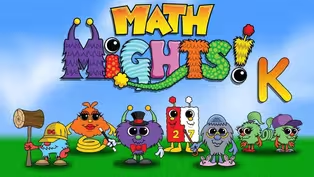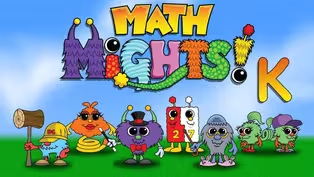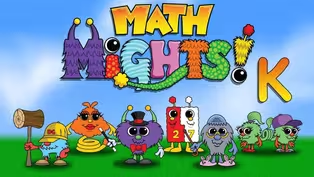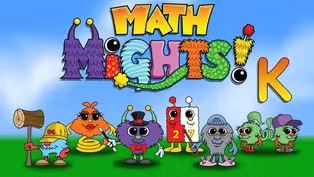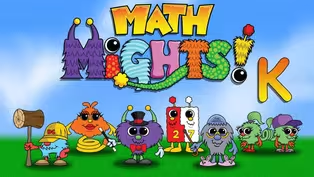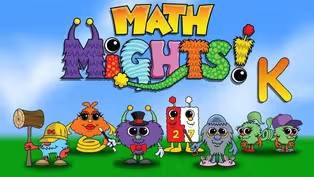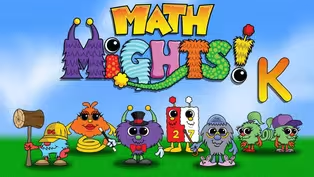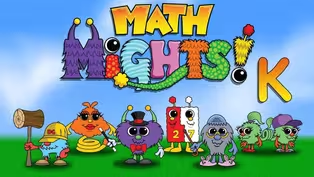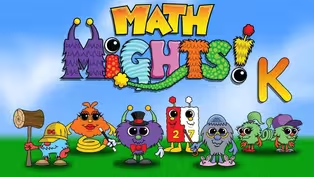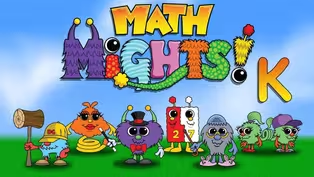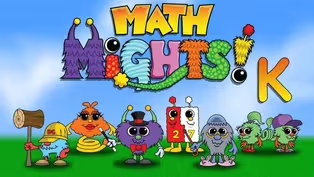Math Mights
Unknown Addend Word Problems
Season 3 Episode 309 | 15m 52sVideo has Closed Captions
Join Mrs. Gray for a subtraction word problem with Porfessor Barble!
Join Mrs. Gray for a subtraction word problem with Porfessor Barble! Next we are going to take word problems to a new level with putting together/taking apart with both addends unknown. I wonder if you will be able to come up with ALL of the ways to solve!
Problems playing video? | Closed Captioning Feedback
Problems playing video? | Closed Captioning Feedback
Math Mights is a local public television program presented by Detroit PBS
Math Mights
Unknown Addend Word Problems
Season 3 Episode 309 | 15m 52sVideo has Closed Captions
Join Mrs. Gray for a subtraction word problem with Porfessor Barble! Next we are going to take word problems to a new level with putting together/taking apart with both addends unknown. I wonder if you will be able to come up with ALL of the ways to solve!
Problems playing video? | Closed Captioning Feedback
How to Watch Math Mights
Math Mights is available to stream on pbs.org and the free PBS App, available on iPhone, Apple TV, Android TV, Android smartphones, Amazon Fire TV, Amazon Fire Tablet, Roku, Samsung Smart TV, and Vizio.
Providing Support for PBS.org
Learn Moreabout PBS online sponsorshipMore from This Collection
Video has Closed Captions
Join Mrs. Gray for a subtraction word problem with Porfessor Barble! (15m 59s)
Video has Closed Captions
Join Mrs. Gray for a subtraction word problem with Professor Barble! (15m 59s)
Video has Closed Captions
Join Mrs. Gray for a subtraction word problem with Professor Barble! (15m 59s)
Compose & Decompose Numbers to 9
Video has Closed Captions
Join Mrs. Gray for a word problem with Professor Barble! (16m 1s)
Break apart pattern block designs
Video has Closed Captions
Join Mrs. Gray for a word problem with Professor Barble! (15m 59s)
Video has Closed Captions
Join Mrs. Gray for a word problem with Professor Barble! (15m 59s)
Addition & Subtraction Expressions
Video has Closed Captions
Match fun story problems with the correct addition or subtraction expression. (16m 15s)
Video has Closed Captions
Join Mrs. Gray for a word problem with Professor Barble! (15m 59s)
Subtraction with Word Problems Part 2
Video has Closed Captions
Join Mrs. Gray & Dotson for a Numeracy Talk with My Counting Buddy Junior! (16m)
Video has Closed Captions
Join Mrs. Gray & Dotson to talk about numbers with My Counting Buddy Junior! (16m)
Addition Word Problems with Quick Draws
Video has Closed Captions
Join Mrs. Gray for Numeracy Talk with Dotson working on conservation to 10. (16m)
Providing Support for PBS.org
Learn Moreabout PBS online sponsorship(playful music) (electronic gadgets whirring and ringing) - [Kids] Math Mights!
- Hi, Kindergarten Math Mights!
My name is Mrs. Gray.
I can't wait to do math with you today.
Today, we are going to be doing a word problem with our friend Professor Barble.
We're also going to be doing an unknown addend word problem.
Let's get ready to see Professor Barble.
Here he comes now.
(triumphant music) Professor Barble is an adventurer.
He always wears his thinking cap.
On the top of his thinking cap, there's a pole and four arrows.
That hat helps remind Professor Barble that when he gets to a word problem, he needs to stop and he needs to think about which way he's going to go before he starts his problem.
Today, we're gonna be using our journal template to help us go through one of Professor Barble's word problems.
On this template, we're going to be going nice and slow and think about each part of the problem as we solve it.
Here's Professor Barble's word problem for today.
Steve has nine golf balls in a bucket.
He used three of them to play golf.
How many golf balls does he have left?
Now we're gonna read the problem again.
After I read it, I want you to try to read it with me.
We're also gonna add in our chunks, that way we can separate out the pieces of information.
Steve has nine golf balls in a bucket.
This is where we're gonna add our first chunk because we have our first piece of information.
Let's keep going.
He used three of them to play golf.
This is where we're gonna add in our second chunk.
The second chunk goes there because that was our second piece of information.
Now it says, how many golf balls does he have left?
That is where we're gonna add our third chunk for our third piece of information.
Let's look at the sentence that matches the problem for what we're going to solve.
It says, Steve has hmm golf balls left.
We know that that is what we're gonna be hunting for in the problem.
How many golf balls does he have left in the bucket?
Now let's go down to our mat and we're gonna act out our problem.
Today for our problem, I'm going to be using two-sided counters.
If you don't have two-sided counters, you could use anything else you could find.
You could use coins or a snack like Cheerios or Cheez-Its.
You could even rip up pieces of paper to help show the golf balls.
Let's show the nine golf balls that he had.
Can you count with me?
One, two, three, four, five, six, seven, eight, nine.
Steve then used three of those golf balls to play golf.
So we need to get rid of them off of our mat.
We're just gonna move them to the side.
Help count with me.
One, two, three.
How many golf balls did he have left?
Let's count.
One, two, three, four, five, six.
There were six golf balls left in his bucket.
Now we're gonna go to the journal template and we're going to do our Quick Draw to show the problem.
There were nine golf balls.
One, two, three, four, five, six, seven, eight, nine.
Three of them are used to play golf.
We're gonna show that by crossing them off on our journal template.
One, two, three.
There are six golf balls left in his bucket.
Let's organize that into our 10 frame.
He had nine golf balls to start with.
One, two, three, four, five, six, seven, eight, nine.
He used three of those balls to play golf.
Let's cross them off.
One, two, three.
There were six golf balls left.
Now we can take that information and put it into our number bond.
We know that he started with nine golf balls.
Here's where they comes at the top.
He started with nine.
Then three of those golf balls were used to play golf.
And the other piece is the six golf balls that were left in the bucket.
Three and six make the nine.
Let's draw it in our number bond.
There were nine golf balls to start.
He used three of them to play golf and six were left in the bucket.
You're doing a great job!
Let's see if we can do the number sentence.
I know this is gonna be a subtraction problem because we take some golf balls away.
We know whenever we take something away, it will be a subtraction problem.
Let's do it.
There was nine golf balls in the bucket.
He took away or minused three of them.
That means he had six left in the bucket.
Let's go back to that sentence and add in the number six to show that he had six left in his bucket.
Steve has hmm golf balls left.
We know that Steve had six golf balls left.
You did such a great job helping me on that word problem.
Professor Barble would be so proud of you.
Let's take a look at our I can statement for today.
I can solve word problems with both addends unknown.
I have a picture here to show you and I want you to take a look at it.
Which one does not belong?
Hmm.
That's kind of a tricky question.
Let's take a look at what our friends think.
Today, I have Javier and Miguel here to share their thoughts.
Javier said that he thought that A did not belong because it's the only one that doesn't have two colors.
Let's take a closer look at what Javier was saying.
Javier said that A didn't belong because it was the only one that didn't have two colors.
I see what he says.
These are all blue.
In the other ones, we have two colors.
Hmm.
That was a good thought.
Let's hear what our friend Miguel says.
Miguel said that he thought B didn't belong because it's the only one that didn't have six.
Let's take a closer look at his thought.
Looking here, I can see what he was saying.
There is only five in letter B.
There is two and three more.
And over here for A, there's six, six, and six.
That was it good thought, Miguel!
Let's take a look at another thought that Javier has.
Javier said that he thought C didn't belong because it was the only one that didn't use connecting cubes.
Let's take a closer look at his thought.
Looking at the four pictures, I see what he was saying.
The letter C uses two-sided counters where all the other ones use the connecting cubes.
Great thinking!
Now let's see what our friend Miguel says.
Miguel said that he thought D didn't belong because it's the only one that was not separated into two different groups.
Let's take a look at what his thought was.
Looking at the four pictures, I see what he said.
This, in D, is connected in one big tower.
In A, they're separated, and B and C are separated.
Hmm.
I wonder which one you thought didn't belong.
Let's take a closer look at the problems.
Which math tool shows different ways to break apart six?
What different ways do you see to break apart six?
Let's take a closer look at the different ways.
When I look at the letter A, I can see that there are six cubes.
They are broken apart into a group of three and three.
Hey, we could write a number sentence that would match that picture.
Let's do it.
Three plus three equals six.
Let's look at B.
B doesn't have six.
B only has five.
I know it has five because there are two and three more.
Let's keep going and take a look at C. On C, I can see that there are six.
There are a group of five and one more.
Do you think you could help me write the number sentence?
Five and one more equals six.
Let's write it.
Five plus one equals six.
Let's check out letter D and see that one.
Looking at D, I can see that there is also six.
There is two blue connecting cubes and four of the yellow.
Two and four is six.
Can you help me write the number sentence?
Let's do it!
Two plus four equals six.
We were able to find so many ways to break apart six.
If I was looking at those four pictures, I think I would say that B didn't belong, because when we had that question, we were really concentrating on the number six, and B was the only one that didn't have six in the box.
Great job, Math Mights!
Many families and cultures make special desserts.
This is a picture of some paletas.
Paletas are a type of ice cream that is popular in Mexico.
These are usually made with some type of fruit.
Today in our word problem, we're gonna be using the idea of paletas.
Jada made six paletas with her brother.
They made two flavors, lime and coconut.
How many paletas were lime?
How many were coconut?
Hmm.
Let's take a look at what our friends Javier and Miguel have to say about that word problem.
Our friend Javier thinks that this is a very tricky word problem because they didn't tell us exactly how many lime and exactly how many paletas were coconut.
Our friend Miguel wonders if we can represent this story in multiple ways.
Let's take a closer look at how they represented the story.
Our friend Javier thought that they could have five lime and one coconut.
Our friend Miguel said they could have one lime and five coconut.
Let's take a closer look at what Javier said.
Javier said that there could be five lime and one coconut.
We could write that as a number sentence.
Five plus one equals six.
I think we should keep going on our 10 frame to show other ways we could represent the problem.
Let's flip over one more chip so that we have four lime and two coconut.
We could write that as four plus two equals six.
Let's keep going.
We could flip over another chip to show that we have three and three.
Let's write it as a number sentence.
Three lime plus three coconut equals six.
Let's keep going.
Let's make it so we have one more for the coconut.
There is two lime and four coconut.
We could write that as two plus four equals six.
Then we could flip it again and we could show that there is one lime and five coconut.
I could write that as a number sentence too.
It would be one plus five equals six.
Wow!
Look at all the different ways we were able to represent the paletas in our story problem.
You did so great helping me show the problems in multiple ways.
Now you are gonna get a chance to do it too.
And you're gonna come up with as many ways as you can to represent the problem.
I am so proud of you.
You did a great job and worked so hard today.
I can't wait for you to come back soon.
(playful music) (cheerful whistling music) - [Boy] Sis4teachers.org.
- [Girl] Changing the way you think about math.
- [Announcer] This program is made possible with funding from the Michigan Department of Education, Governor's Education Emergency Funds, the State of Michigan, and by viewers like you.
(cheerful music continues)


- Home and How To

Hit the road in a classic car for a tour through Great Britain with two antiques experts.










Careers that Work

Support for PBS provided by:
Math Mights is a local public television program presented by Detroit PBS
